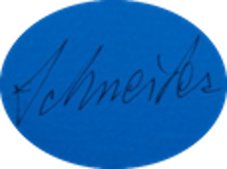

(Sainte-Croix, Suisse, 1896 - Paris, 1986)

A painter of Swiss origin, Gérard Schneider (1896-1986) is undoubtedly one of the greatest masters of lyrical abstraction, a movement of abstract art which triumphs at the end of the Second World War and participates in the " art history of the 20th century alongside French artists such as Debré, Estève, Manessier, Mathieu, Soulages, Russians Poliakoff and Staël, German Hartung, American Jenkins, Portuguese Vieira da Silva or Chinese Zao Wou-Ki.
After his installation in Paris and until the eve of the 1939-1945 war, Gérard Schneider improved his knowledge of painting, restored old paintings and composed his first abstract works while indulging in music, his other passion. The post-war years during which he asserts himself as an abstract painter are for him a decisive turning point.
In 1947, Schneider exhibited for the first time with Hans Hartung and Pierre Soulages at the Salon des Surindépendants. After experiencing multiple techniques, he reaches a gestural expression, where forms, signs and colors burst with force, emotion, passion, in a modern romanticism where dominance instantaneity and vehemence
He entered Lydia Conti gallery (with Hartung) who was an important support for birth of after-war abstract art. The art dealer dedicated to him a first solo show in 1947. During the 1950’s he only made painting.
In 1948, he obtained French nationality and participated for the first time to Venice Biennale. His creations are shown in itinerant exhibitions in Germany and Austria, and sometimes in Brasilia. He published his first write “In favour or against Abstraction” on Journal des Arts. In 1949, the group of Lydia Conti gallery (Hartung, Soulages,.. ) exhibited in New York at Betty Parsons’, then entered Gallery Louis Carré in 1850. During this time, the painting of Schneider reached maturity. The artist wanted to eradicate all effects of perspective and depth to respect plan. Schneider painted non-geometrical forms, but juxtaposed and interlocked each other’s as a puzzle where there is no more content and form.
In 1953, a great personal exhibition is dedicated to him in Brussels at Beaux-Arts, with big paintings liberally composed but solidity acquired during his researches on wall painting.
He met the Japanese artist Yoshikawa. In 1954, he exposed again at Venice Biennale in the French Pavilion with Bissière, Estève, Hartung, Viera da Silva and Nicolas de Stael. The presence of French artists in New York – Soulages and Mathieu in 1954, Shcneider in 1955 – influenced the American painting. Schneider exhibited at Kootzs’ in 1956. In 1959, his first monograph is published.
During the 1960’s in New York, the Lyric Abstraction was already joined by others avant-garde movements: Pop Art, Op’Art, Minimal, etc. After United States, he went to Italia and entrusted his works to art dealer Lorenzelli.
He was inspired by cut papers of Matisse and created a light painting until 1975, ten years of researches. His artworks are recognized in several exhibitions in Europe (Turin, Brussels, Paris) et died at the age of 90, having worked until the end of his life.